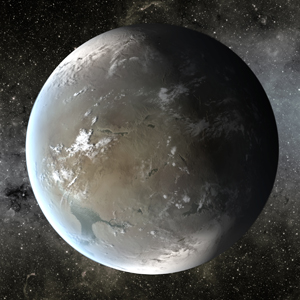But Kepler-62f Offers No Oasis When Earth Runs Out.

Artist’s concept of Kepler-62f. Located about 1,200 light-years from Earth in the constellation Lyra, it orbits its host star every 267 days and is roughly 40 percent larger than Earth in size.
For my (tax) money, the most fascinating NASA program is the $600 million Kepler mission. Launched March 6, 2009, it searches for Earth-like planets outside our solar system, worlds that lie “in the habitable zone of their stars where liquid water and possibly life might exist.” The search for planets like Earth is a search for water.
NASA conducts much groundbreaking research relevant to our relationship to the planet, such as its work on climate change and the atmosphere. I am particularly taken with the Kepler mission. If life is not a proprietary innovation of Earth’s, and it is likely not, there is much we do not understand about life itself and the much larger environment we call home. We can learn from other worlds. Kepler is also a pointed reminder that water is a fundamental requirement for life, though there are dissenting opinions.
But unfortunate news came last week when NASA reported an equipment failure may imperil the continued operation of Kepler itself, though years of data can still be analyzed. The announcement sent consternation through the space community, where Kepler is considered a profound and elegant mission, “a gift to humanity,” in the words of one astronomer.
So far, NASA has confirmed 132 new planets and identified 2,740 planet candidates, none of which have been given official Earth-like status. The closest came on April 18, when NASA reported the discovery of “Kepler-62f”, which resides in “a five-planet system where all the planets are smaller than twice the size of Earth and where the two outermost planets orbit in the habitable zone of their star.”
Reality Check: Kepler-62f offers no oasis for Earthlings if we ruin the .007% of our planet’s water supply available to us. At the speed of today’s fastest spacecraft, it is 5 million years travel time. 200,000 generations will have to breed during the trip. The equivalent water consumption for one Kepler-62f-bound occupant who made the entire journey is 5 ½ million tons, given NASA’s current allotment of six gallons per person, per day.
I am reminded of Carl Sagan’s warning: “There is no hint that help will come from elsewhere to save us from ourselves.”
Additional Links:
Interactive guide to Kepler’s confirmed planets, by The New York Times
Johannes Kepler (in case you do not remember him from elementary school science.)









